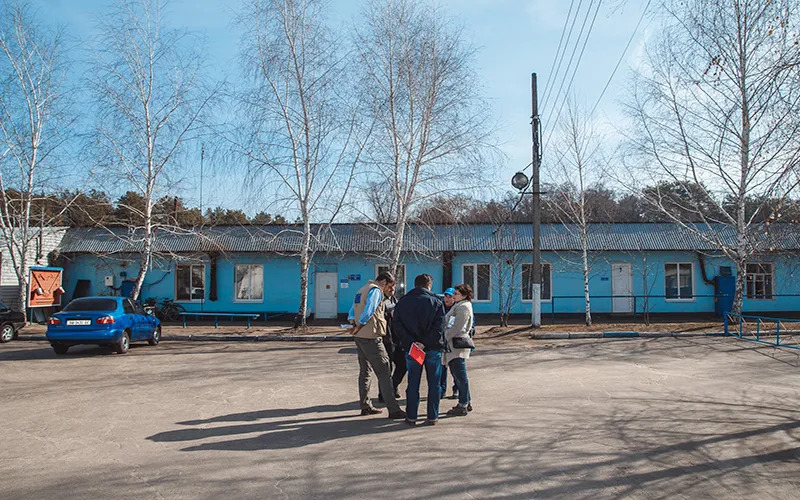-
CENTRES
Progammes & Centres
Location
While the world remains engrossed in the debates triggered by Western sanctions on Russia over Ukraine and the countersanctions, a serious humanitarian crisis is building up in Ukraine which needs international attention and help.

While the world remains engrossed in the debates triggered by Western sanctions on Russia over Ukraine and the countersanctions, a serious humanitarian crisis is building up in Ukraine and the region in this freezing winter. The continuing Ukraine crisis has already resulted in more than 514,000 becoming internally displaced persons (IDPs), according to the latest Ukrainian State Emergency Service. The UNHCR estimates put the number of the IDPs here at 260,000. Such a rise in the magnitude of cases within such a short of time spells out the gravity of the entire situation.
As the winter intensifies and the sanctions begin to impact the concerned countries, there loom several question marks on the fate of these IDPs in Ukraine who are actually facing the brunt of the crisis. Unemployment, lack of basic facilities and now the harsh weather seem to be making their life miserable.
Majority of these IDPs are in the eastern part of Ukraine, which is badly affected by the conflict between the Ukrainian army and pro-Russian separatists aligned with the self-proclaimed Donetsk and Luhansk People's Republics. According to the spokesman for UNHCR, Adrian Edwards, "Fighting in the east, and the resulting breakdown of basic services, continues to drive more people from their homes". If reports are to be believed, approximately 95% of the clashes have been reported in Donetsk, Kharkiv and Kyiv while the remainder have been found to be displaced from Crimea. According to the United Nations Office for the Coordination of Humanitarian Affairs (OCHA), 5.2 million Ukrainians live in areas affected by conflict, and OCHA expects more of them to become internally displaced as fighting continues.
Interestingly, women and children constitute most of the IDPs. Most men either choose to stay behind in order to protect property or sometimes they have to stay because they are prevented by the armed groups from leaving. According to UNHCR, 65% of the adult displaced population are women while 27% are children and 21% elderly or disabled people. This figure is despite the fact that not all displaced persons are registered with the authorities as a centralised registration system for keeping a track of IDPs came into existence only on October 15 this year.
The very uncertain future of Ukraine has, in turn, forced a large number of people to resettle in other areas. Nearly 172,000 people had applied for asylum in neighbouring countries in Europe, including more than 168,000 people in the Russian Federation. A further 149,000 applied for other forms of legal stay in the Russia. According to Russia's Federal Migration Service, around 233,000 people have already applied for refugee status or temporary asylum in the Russian Federation. As is obvious, the largest chunk of people has fled to the Russian Federation.
With protests and clashes breaking out quite often in the region, there is an urgent need for international attention on the problems of these IDPs. The UN and international aid and efforts need to be properly allocated and closely monitored. Local administration needs to take charge of the situation and ensure proper food and other essential supplies to the displaced people.
Risks of human trafficking arise in conflict prone areas; hence the law and order situation needs to be sound enough to be able to prevent IDPs from such situations. On October 20, 2014 the Parliament of Ukraine did pass the Bill "On Ensuring the Rights and Freedoms of Internally Displaced Persons" No. 4490�-1 into law which identifies temporarily IDPs and determines the procedure for their obtaining employment, social services and appropriate assistance. However, since this procedure is paper-based, it leads to a lot of apprehensions in terms of practical application. According to UN monitoring, applicants are required to wait in two different lines to register and receive financial aid. Possibilities of inefficiency, duplication, red-tapism linger large on the applicability of such law, considering that one administrator can register an average of only 16 people per day. Moreover, the issue of tax exemption still needs to be addressed in order to guarantee the effective and efficient delivery of humanitarian assistance.
While there is no short term solution to the situation available, efforts need to be made to ensure the well-being of IDPs. The UNHCR has claimed that it is working on this front by citing the Cluster Approach that it is using to ensure care and protection of IDPs. In spite of this, the biggest challenge for it still remains ensuring equal allocation of basic facilities in and around Ukraine. For IDPs to survive the freezing temperatures, one of the basic challenges would be to ensure weather proof shelters considering the severity of winter in the region and the fact that about 20% of the displaced population are relying on collective shelters.
Access to food, shelter and medical facilitates are the basic requirements of every individual. Hence the authorities need to ensure that IDPs are not deprived of them. Temporary employment and allowances also need to be allocated for ensuring self sufficiency among the displaced individuals.
(The writer is a Research Intern at Observer Research Foundation, Delhi)
The views expressed above belong to the author(s). ORF research and analyses now available on Telegram! Click here to access our curated content — blogs, longforms and interviews.